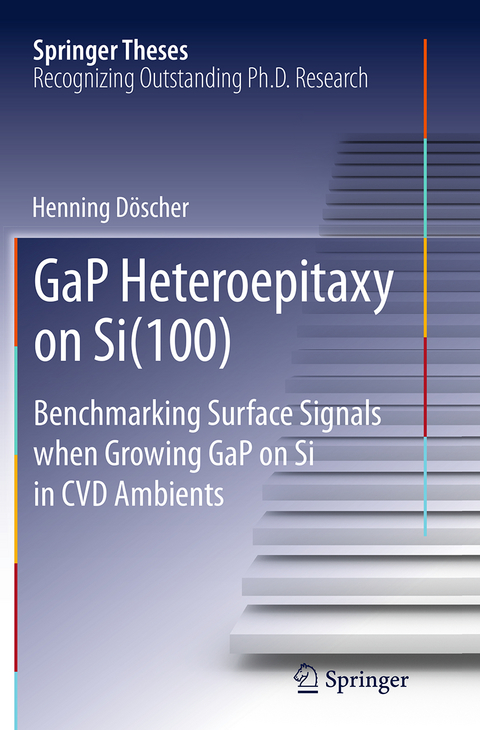
GaP Heteroepitaxy on Si(100)
Benchmarking Surface Signals when Growing GaP on Si in CVD Ambients
Seiten
2016
|
1. Softcover reprint of the original 1st ed. 2013
Springer International Publishing (Verlag)
978-3-319-37955-5 (ISBN)
Springer International Publishing (Verlag)
978-3-319-37955-5 (ISBN)
This thesis offers a key contribution to improving optoelectronic devices and performance of photovoltaic materials. It reports almost lattice-matched growth of thin gallium phosphide films as a viable model system for III-V/Si(100) interface investigations.
Epitaxial integration of III-V semiconductors on silicon substrates has been desired over decades for high application potential in microelectronics, photovoltaics, and beyond. The performance of optoelectronic devices is still severely impaired by critical defect mechanisms driven by the crucial polar-on-nonpolar heterointerface. This thesis reports almost lattice-matched growth of thin gallium phosphide films as a viable model system for III-V/Si(100) interface investigations. The impact of antiphase disorder on the heteroepitaxial growth surface provides quantitative optical in situ access to one of the most notorious defect mechanisms, even in the vapor phase ambient common for compound semiconductor technology. Precise control over the surface structure of the Si(100) substrates prior to III-V nucleation prevents the formation of antiphase domains. The hydrogen-based process ambient enables the preparation of anomalous double-layer step structures on Si(100), highly beneficial for subsequent III-V integration.
Epitaxial integration of III-V semiconductors on silicon substrates has been desired over decades for high application potential in microelectronics, photovoltaics, and beyond. The performance of optoelectronic devices is still severely impaired by critical defect mechanisms driven by the crucial polar-on-nonpolar heterointerface. This thesis reports almost lattice-matched growth of thin gallium phosphide films as a viable model system for III-V/Si(100) interface investigations. The impact of antiphase disorder on the heteroepitaxial growth surface provides quantitative optical in situ access to one of the most notorious defect mechanisms, even in the vapor phase ambient common for compound semiconductor technology. Precise control over the surface structure of the Si(100) substrates prior to III-V nucleation prevents the formation of antiphase domains. The hydrogen-based process ambient enables the preparation of anomalous double-layer step structures on Si(100), highly beneficial for subsequent III-V integration.
Dr. Henning Döscher TU Ilmenau Institut für Physik, FG Photovoltaik Ehrenbergstr. 29 98693 Ilmenau
Introduction.- Experimental.- Si(100) surfaces in chemical vapor environments.- GaP(100) and InP(100) surfaces.- GaP growth on Si(100) and anti-phase disorder.- Conclusion.
| Erscheinungsdatum | 15.09.2016 |
|---|---|
| Reihe/Serie | Springer Theses |
| Zusatzinfo | XIV, 143 p. 80 illus., 33 illus. in color. |
| Verlagsort | Cham |
| Sprache | englisch |
| Maße | 155 x 235 mm |
| Themenwelt | Naturwissenschaften ► Physik / Astronomie ► Atom- / Kern- / Molekularphysik |
| Naturwissenschaften ► Physik / Astronomie ► Optik | |
| Technik ► Elektrotechnik / Energietechnik | |
| Technik ► Maschinenbau | |
| Schlagworte | Anti-phase Disorder • Applied Optics • Electronic devices and materials • III-V Semiconductor Heteroepitaxy on Silicon Subst • III-V Semiconductor Heteroepitaxy on Silicon Substrates • In Situ Reflectance Anisotropy Spectroscopy • Lattice-matched Growth • Materials for Photovoltaics • Metal-organic Vapor Phase Epitaxy • optical and electronic materials • optical physics • Optics, Optoelectronics, Plasmonics and Optical De • Physics and Astronomy • Polar on Non-polar Interface • semiconductors |
| ISBN-10 | 3-319-37955-0 / 3319379550 |
| ISBN-13 | 978-3-319-37955-5 / 9783319379555 |
| Zustand | Neuware |
| Haben Sie eine Frage zum Produkt? |
Mehr entdecken
aus dem Bereich
aus dem Bereich
Buch | Softcover (2024)
Wiley-VCH (Verlag)
CHF 83,85


